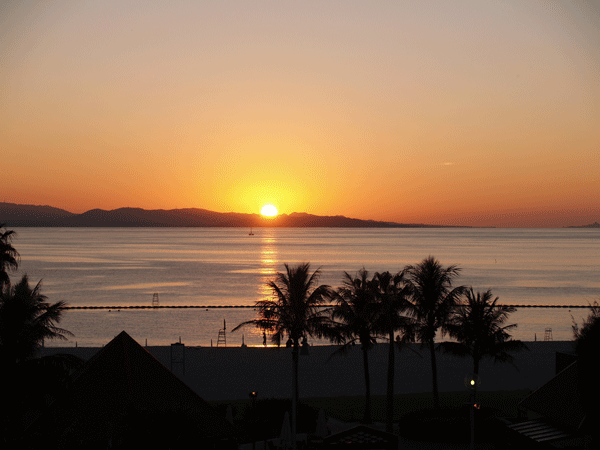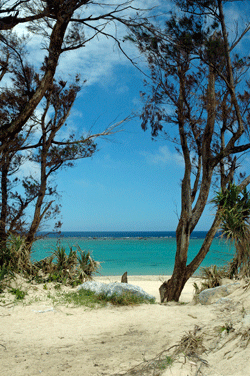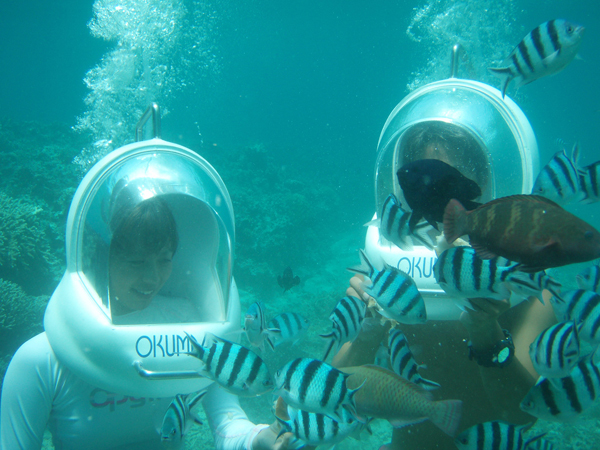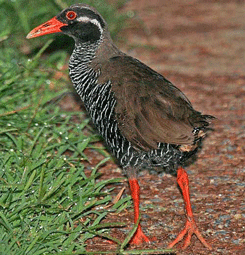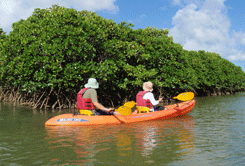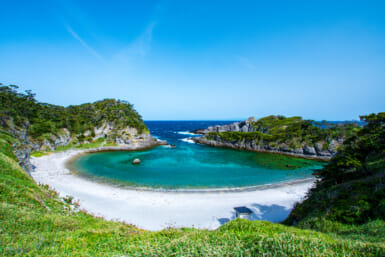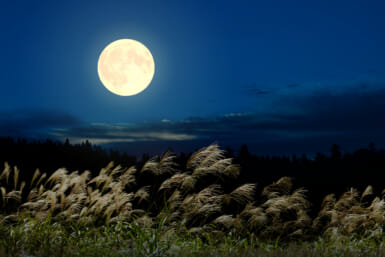Yanbaru – The back country of Okinawa: an alternative Japanese getaway
By Andy Gayler
People are always telling you about the best places you’ve never been, the top holiday retreats you should visit before you die and just plain the world’s most amazing beach getaways. Well, they’re all very well and good and I’m sure you’ve even visited a few of them for yourself. But I wonder if you’ve ever thought about that beach holiday being here, in Japan. Be honest now.
And why would you? Japan, to most, is hi-tech, futuristic cityscapes, kitsch crazes and old temples. Of course, it’s got hot spas and mountain trekking, too. You can even dress up as a geisha or a samurai for a souvenir photo. You may well have done so on that weekend trip to Kyoto (especially when visitors from back home were over and wanted to experience the ‘real’ Japan). It’s what we all know.
But that’s not really the whole picture, is it? There’s somewhere you’re forgetting, perhaps. Or maybe you’ve never even thought about it in the first place – except, that is, when it hits the headlines for all the wrong reasons because of island disputes with the Chinese, North Korean rockets flying over it or controversial issues such as the new Osprey aircraft heading to US air bases.
Yes, that’s it, Okinawa. Those little islands far to the south where mainlanders spend a small fortune getting married and students go for their summer break while the foreign community heads to neighbouring countries for their ‘down time’.
Well, if all you know about the most distant prefecture comes from news bulletins then you probably don’t know much. For a start, you probably don’t know about the dozens and dozens of sub-tropical islands with warm seas, coral reefs and golden sands.
Furthermore, you may find it hard to believe that in this small country of 126 million people, where 70 per cent of the land is mountainous and the rest seems to be sardine-packed with humans, you could have one of these superb, pristine beaches all to yourself with very little effort. What’s more, because no one talks much about Okinawa being the poorest prefecture in Japan, few realise it is also a much cheaper destination for anyone looking to see something more of this land of the rising sun but who is scared by the costs involved.
But all of this is exactly what the traveller in Japan who’s willing to go just that little bit further can have. A three-hour flight from Tokyo to Naha, Okinawa’s capital and main airport (without the visa and immigration hassles of a trip abroad) and then a two-hour drive, or slightly longer bus journey, will put you right in the heart of Yanbaru (‘the back country’), as the locals call it, the rural northern area of Okinawa Honto (main island) – the largest island in the Ryukyu archipelago.
It’s easy, with an international driver’s licence, to hire a car and road signs are straightforward to follow as you leave behind the urban sprawl of the south and enter increasingly isolated settlements in the forested north.
Idyllic Beaches
Once there you can take a picturesque driving tour on coast-hugging roads where few bother to venture, stopping off at any number of the idyllic beaches along the way. Some have names, Uppama, Ada, Izena, or simply the beach at Kayo village, but many don’t. Some have car parks, toilet and shower facilities and nearby refreshments, others are hidden down small country tracks and behind trees just waiting to be discovered. And on most of them you can even pitch up a tent and camp for the night should the spirit take you.
What could be better than a night under the stars, seeing the Milky Way for the first time in who knows how long if you’ve been living the fast life in the big metropolis for a while, and sitting around a real camp fire while the waves lap the warm, golden sands?
Ten other great things you can do up north:
1. Visit Daisekirinzan – incredibly mysterious rocks and the top spiritual site of the island
2. Stand at the northernmost point – Cape Hedo – with stunning cliff views of distant islands
3. Look out for Okinawa’s unique wildlife – Okinawa rail (Yanbaru Kuina – a flightless bird), the Habu snake (but keep away) and the critically endangered Okinawa Spiny Rat (Tokudaia muenninki) among them
4. Visit Ogimi village – famed for the oldest living people in the world and watch traditional weavers in action
5. Trek in the sub-tropical rain forest, visit waterfalls galore – Hiji among the biggest – and swim in the river (particularly nice on a humid summer day)
6. Ride a horse along the beach or through the forest with an easy-to-organise tour
7. Kayak through mangroves along the River Gesashi, or meander along the ocean coast
8. Sample Okinawan cuisine – with vegetables and fruit you’ve never even heard of (and don’t forget the sweet potato ice cream, yum)
9. Scuba dive terrific reef walls that are home to colourful Pacific fish and coral
10. Visit Churaumi Aquarium, the second biggest aquarium in the world – replete with outdoor dolphin show, stunning coral tanks, a number of ‘friendly’ whale sharks and some scarier bull and tiger sharks too
The beaches themselves are a cross between the Australian – with rocks and rock pools, beige sand and rugged plant life providing a glorious natural ‘sea wall’ to the interior – and the warm, clear blue tropical waters of South East Asia.
Don’t forget your snorkel and fins – endless rocks and reefs provide a home to a massive variety of Pacific Ocean sea life: colourful wrasses, lion fish, octopuses, morays, turtles, nudibranches, puffer and box fish, squid, jellyfish, anemones and many, many more. Which is why this is also one of the diving community’s best-kept secrets. Forget the underwater crowds of Koh Tao in Thailand and the hordes at the Great Barrier Reef; here you can have the sea to yourself and still enjoy top-notch dive sites (including incredible war time wrecks).
Even if you go during the coldest months of January and February you may find a few days where a T-shirt and shorts will suffice – although it’s best to bring a sweater and jacket and possibly leave the swimming costume behind. Think autumn in Tokyo for an idea of what Okinawa’s winter has in store, with the rest of the year like the summer.
So, in case you’re asking, why is it so quiet if it’s so great? The answer is simply that most foreigners living in Japan head off to cheaper neighbouring countries for their longer holidays and most Japanese people heading to Okinawa don’t like to venture off the well-beaten tourist track.
Even if they do, the Japanese company life simply doesn’t allow time to get to the remoter parts and see and do all the usual tourist activities – among them visiting castles and museums, enjoying unique live folk music, doing marine sports, pottery and glass making or even catching an Eisa festival or dragon boat race. But your one probably does, so what are you waiting for? You’ll not find many people who can say they holidayed in Yanbaru, that’s for sure.
Did You Know?
Sadly, Okinawa is only really known to most of the world because of its pivotal role in the second world war, when it suffered the worst land battle of the Pacific war and was the only inhabited Japanese soil to be invaded.
More than 95,000 Japanese military personnel were killed, possibly as many as 150,000 Okinawan civilians, or one in four, were caught in the cross fire or committed suicide (compulsory mass suicides, or shudan jiketsu, reportedly resulted from a vicious propaganda campaign) and more than 12,000 Allied military personnel also lost their lives.
It was to be the last significant battle of the war as Japan was soon provoked into a speedier surrender by the dropping of atomic bombs on Hiroshima and Nagasaki. But this particularly sad tale is even more poignant when considered alongside the fact that Okinawa was still the independent kingdom of Ryukyu until it was annexed in 1872 (and even then it wasn’t given full prefectural status for another seven years) and was the last area in Japan to be handed back by the USA after the second world war – in 1972!
Camping
A number of campsites in the north will rent you the right equipment and provide good facilities. Or, if you can get your own gear, pick a beach and put up your tent for a night under the stars.
Campsites include Hiji Campground (0980-41-3636), tucked away in the forest and the starting point for a pleasant 40-minute jungle walk to the Hiji waterfalls, with spaces costing 2,000 yen. And the Tsutsuji Eco Park (0980-43-3300) is another nice spot that charges 3,500 yen for a tent space and 200 yen per adult (100 yen for children).
How to get there
Japan’s main airlines, JAL and ANA, connect most of the country’s big cities and budget flights airlines, such as Skymark, Jetstar and AirAsia, do great deals connecting Tokyo to Naha, Okinawa. And there are numerous routes linking other Asian cities to Naha to consider if you want to incorporate a visit into a much bigger journey. Check online for the best deals as prices can vary considerably throughout the year.
Getting around
It’s best to hire a rental car at Naha International Airport and take the Highway 58 north (or the Express Toll Road north before joining the 58 further up) and simply follow it around the coast. It changes to the highway 70 on the east coast as you head back south. Buses will also take you to the north but are not as frequent as the ones you may find in Osaka and Tokyo, so having time on your hands and adopting the easy-going Okinawan way is key. Except for a limited monorail in Naha, there are no trains in Okinawa.
Useful websites
Okinawa prefecture site: www.pref.okinawa.lg.jp
Okinawa tourism site: www.okinawastory.jp
Photos: Andy Gayler and JAL Private Resort Okuma

